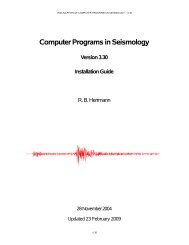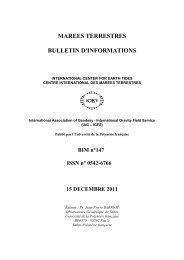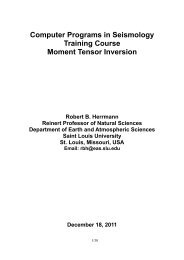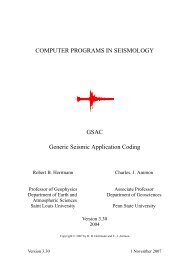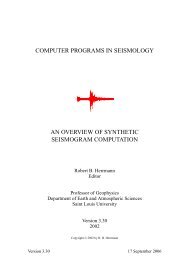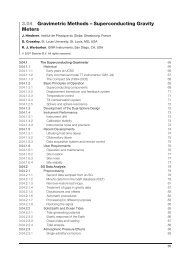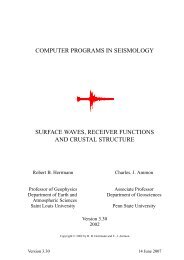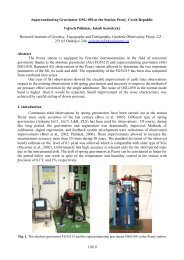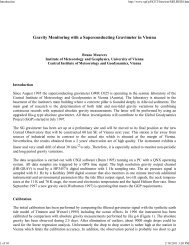LLR and Tidal Effects - the Department of Earth and Atmospheric ...
LLR and Tidal Effects - the Department of Earth and Atmospheric ...
LLR and Tidal Effects - the Department of Earth and Atmospheric ...
Create successful ePaper yourself
Turn your PDF publications into a flip-book with our unique Google optimized e-Paper software.
epproo10<br />
http://www.upf.pf/ICET/bim/text/WG6<strong>LLR</strong>.htm<br />
2 <strong>of</strong> 5 2/18/2011 3:26 PM<br />
models <strong>the</strong> degree 2 part. Additionally, a correction is applied to consider <strong>the</strong> different Love number for <strong>the</strong><br />
K 1 tide with a maximum amplitude <strong>of</strong> about 1.2 cm (see e.g. IERS St<strong>and</strong>ards (1992), p. 57). The pole tide<br />
effect <strong>and</strong> high-frequency variations in UT1 have also been implemented.<br />
No attempt was made to determine <strong>Earth</strong> tidal parameters. Estimations had shown that <strong>the</strong> <strong>LLR</strong> observation<br />
time is correlated with <strong>the</strong> M 2 period which means this effect can hardly be determined by <strong>LLR</strong>. But solar<br />
tides or smaller lunar tides might be obtainable (Williams, 1999).<br />
The (secular) tidal acceleration <strong>of</strong> <strong>the</strong> lunar orbit, k 2 t, has been modelled <strong>and</strong> can be solved-for, including <strong>the</strong><br />
diurnal (k 20 = 0.34, k 21 = 0.3, t 21 = 0.012956 days) <strong>and</strong> semi-diurnal (k 22 = 0.3, t 22 = 0.006925 days) terms.<br />
The result for <strong>the</strong> value <strong>of</strong> t given here has been determined using <strong>the</strong> ephemeris DE330 (Williams, 1998).<br />
The Moon is modelled as an elastic, dissipative body. The corresponding terms affect <strong>the</strong> librations <strong>of</strong> <strong>the</strong><br />
Moon. The two parameters k m (= 0.0287) <strong>and</strong> t m (= 0.11523 days) have been determined during <strong>the</strong> global<br />
adjustment.<br />
UTXMO (J. Györgyey Ries)<br />
The effect <strong>of</strong> <strong>the</strong> solid <strong>Earth</strong> tides is computed following <strong>the</strong> work <strong>of</strong> Alsop <strong>and</strong> Kuo (1964), which was based<br />
on Bullen’s model. The Love numbers <strong>of</strong> <strong>the</strong> tidal displacement are h 2 = 0.618 <strong>and</strong> l 2 = 0.088, which are<br />
hardcoded <strong>and</strong> cannot be estimated without substantial effort. Tides raised on <strong>the</strong> Moon by <strong>the</strong> <strong>Earth</strong> <strong>and</strong> <strong>the</strong><br />
Sun are coded, but usually not used. Although <strong>the</strong> s<strong>of</strong>tware is capable <strong>of</strong> estimating <strong>the</strong> lunar Love number,<br />
k 2 , <strong>and</strong> k 2 t, it has not been attempted. Additional tidal effects <strong>and</strong> ocean loading are not considered. At<br />
present, streamlining <strong>of</strong> <strong>the</strong> analysis process takes higher priority than estimation <strong>of</strong> tidal effects.<br />
OBSPM (J. Chapront)<br />
Solid <strong>Earth</strong> tides are computed according to Eq. 8 <strong>of</strong> Chapter 7 <strong>of</strong> <strong>the</strong> IERS Conventions (1996). The Love<br />
numbers <strong>of</strong> <strong>the</strong> tidal displacement are h 2 = 0.609 <strong>and</strong> l 2 = 0.0852.<br />
The (secular) tidal acceleration <strong>of</strong> <strong>the</strong> lunar orbit has been modelled, including <strong>the</strong> effect <strong>of</strong> both <strong>the</strong> diurnal<br />
(k 20 = 0.34, k 21 = 0.3, t 21 = 0.0138569 days) <strong>and</strong> semi-diurnal (k 22 = 0.3, t 22 = 0.0068254 days) terms, where<br />
<strong>the</strong> numerical values have been adopted from <strong>the</strong> JPL ephemeris DE245. The secular lunar tidal acceleration,<br />
k 2 t, is fitted. The effect <strong>of</strong> ocean loading at <strong>the</strong> sites has been considered, but without corrections due to <strong>the</strong><br />
lunar node (IERS Conventions (1996), p. 53). <strong>Atmospheric</strong> loading is modelled using a simplified version <strong>of</strong><br />
<strong>the</strong> formula given in <strong>the</strong> IERS Conventions (1996), p. 67: Dr al = - 0.9 pr [mm], where pr = p 0 -1013 mbar <strong>and</strong><br />
p 0 is <strong>the</strong> local pressure reduced to sea level.<br />
The Moon is modelled as an elastic, dissipative body where <strong>the</strong> two parameters k m (= 0.0299) <strong>and</strong> t m (=<br />
0.16485 days) have been included in <strong>the</strong> computation <strong>of</strong> <strong>the</strong> lunar librations.<br />
FSG (J. Müller)<br />
Previous model:<br />
Solid <strong>Earth</strong> tides were computed according to Eq. 8 <strong>and</strong> 9 (displacements due degree 3 tides) <strong>of</strong> Chapter 7 <strong>of</strong><br />
<strong>the</strong> IERS Conventions (1996). The Love numbers <strong>of</strong> <strong>the</strong> tidal displacement are h 2 = 0.603, l 2 = 0.083, h 3 =<br />
0.292 <strong>and</strong> l 3 = 0.015. A correction was applied to consider <strong>the</strong> different Love number for <strong>the</strong> K 1 tide (see<br />
IERS St<strong>and</strong>ards (1992), p. 57). Also <strong>the</strong> pole tide effect <strong>and</strong> high-frequency variations in UT1 have been<br />
implemented. The effect <strong>of</strong> ocean loading at <strong>the</strong> sites has been considered, following <strong>the</strong> recommendations <strong>of</strong><br />
<strong>the</strong> IERS Conventions (1996), Chapter 7.<br />
The secular tidal acceleration <strong>of</strong> <strong>the</strong> lunar orbit has been modelled, but only <strong>the</strong> semi-diurnal term (k 2 = 0.3,<br />
t 2 = 0.006939 days) which is also solved-for during each adjustment.<br />
Again, <strong>the</strong> Moon is modelled as an elastic, dissipative body where <strong>the</strong> two parameters k m (= 0.0267) <strong>and</strong> t m<br />
(= 0.1709 days) are determined.




